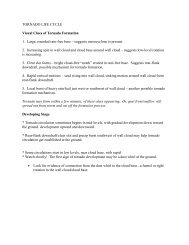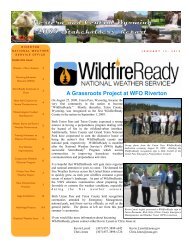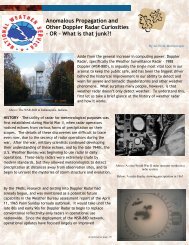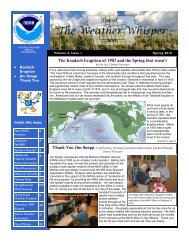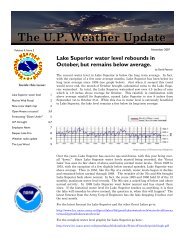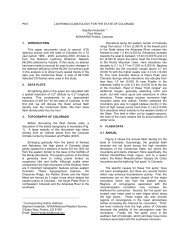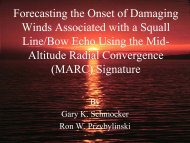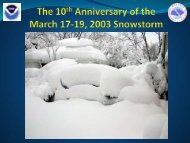Rainfall Totals from the Hermosa Flash Flood of 17 August 2007
Rainfall Totals from the Hermosa Flash Flood of 17 August 2007
Rainfall Totals from the Hermosa Flash Flood of 17 August 2007
Create successful ePaper yourself
Turn your PDF publications into a flip-book with our unique Google optimized e-Paper software.
A look at <strong>the</strong> 300-mb chart <strong>from</strong> 1200 UTC <strong>17</strong> <strong>August</strong> (Fig. 1) indicates westnorthwesterly<br />
flow al<strong>of</strong>t with a weak upper-level ridge over eastern Montana and eastern<br />
Wyoming. By 0000 UTC 18 <strong>August</strong> (Fig. 2) a shortwave trough moving through <strong>the</strong> flow had<br />
flattened <strong>the</strong> ridge causing <strong>the</strong> flow at 300 mb to turn more westerly. This shortwave helped in<br />
<strong>the</strong> initiation <strong>of</strong> convection that evening and can be seen in all <strong>of</strong> <strong>the</strong> analyses to follow. A<br />
similar picture is seen at 500 mb with <strong>the</strong> flow turning <strong>from</strong> westerly at 1200 UTC <strong>17</strong> <strong>August</strong><br />
(Fig. 3) to southwesterly at 0000 UTC 18 <strong>August</strong> (Fig. 4). Again, <strong>the</strong> ridge was flattened by<br />
0000 UTC as <strong>the</strong> wave moved across western South Dakota.<br />
At 700 mb a pressure ridge was present across <strong>the</strong> nor<strong>the</strong>rn Plains with <strong>the</strong> axis stretching<br />
<strong>from</strong> nor<strong>the</strong>astern Montana to eastern Kansas. At this level, strong sou<strong>the</strong>rly flow was evident<br />
with speeds <strong>of</strong> 25 to 40 knots as indicated by <strong>the</strong> Rapid City, South Dakota (KUNR) sounding<br />
observations at 1200 UTC <strong>17</strong> <strong>August</strong> (Fig. 5) and 0000 UTC 18 <strong>August</strong> (Fig. 6). Again <strong>the</strong><br />
shortwave trough was evident as it moved across eastern Wyoming and western South Dakota.<br />
At 850 mb <strong>the</strong> flow was more meridional with high pressure over <strong>the</strong> Midwest and low pressure<br />
over <strong>the</strong> nor<strong>the</strong>rn Rocky Mountains (Fig. 7). Sou<strong>the</strong>rly flow was evident across South Dakota<br />
and Nebraska (Figs. 7 and 8).<br />
The KUNR sounding at 1200 UTC <strong>17</strong> <strong>August</strong> (Fig. 9) indicates a deep layer <strong>of</strong> sou<strong>the</strong>rly<br />
flow <strong>from</strong> <strong>the</strong> surface to approximately 600 mb: an approximate depth <strong>of</strong> 300 mb. At 0000 UTC<br />
18 <strong>August</strong> (Fig. 10) <strong>the</strong> layer <strong>of</strong> sou<strong>the</strong>rly flow extended to <strong>the</strong> termination <strong>of</strong> <strong>the</strong> sounding at<br />
500 mb producing a 400-mb-deep layer. This south to sou<strong>the</strong>asterly flow allowed very moist air<br />
(dew points were in <strong>the</strong> 60s and 70s °F across Nebraska) to advect into southwestern South<br />
Dakota. This deep layer <strong>of</strong> sou<strong>the</strong>rly flow can also be seen on <strong>the</strong> velocity-azimuth display<br />
(VAD) wind pr<strong>of</strong>ile (VWP) (Fig. 11) through 12,000 feet, which is at approximately 650 mb.<br />
The precipitable water value <strong>from</strong> KUNR at 0000 UTC 18 <strong>August</strong> (Fig. 12) <strong>of</strong> 1.41<br />
inches was 189 percent <strong>of</strong> normal, and indicated that a very moist air mass had moved into<br />
western South Dakota. This observation was higher than <strong>the</strong> mean value for <strong>August</strong> by more<br />
than two standard deviations and approached <strong>the</strong> maximum values observed at Rapid City <strong>from</strong><br />
1948 to 2000 (Fig. 13).<br />
2.2 Surface Analysis<br />
At 2100 UTC <strong>17</strong> <strong>August</strong> (Fig. 14) a surface low pressure center was located over eastern<br />
Wyoming with a stationary front draped across western South Dakota and into nor<strong>the</strong>astern<br />
Nebraska. By 0000 UTC 18 <strong>August</strong> (Fig. 15) <strong>the</strong> low pressure center drifted into southwestern<br />
South Dakota and by 0300 UTC (Fig. 16) <strong>the</strong> stationary front had pushed south extending <strong>from</strong><br />
extreme southwestern South Dakota through sou<strong>the</strong>astern Kansas. Prior to convective initiation,<br />
<strong>the</strong> surface temperatures across southwestern South Dakota were well into <strong>the</strong> 90s °F (Fig. <strong>17</strong>)<br />
while north <strong>of</strong> <strong>the</strong> stationary front temperatures were only in <strong>the</strong> 60s °F. Dew points in <strong>the</strong> 60s<br />
°F extended <strong>from</strong> west-central to south-central South Dakota (Fig. 18).<br />
2.3 Discussion<br />
The combination <strong>of</strong> a deep layer (300 mb) <strong>of</strong> south to sou<strong>the</strong>asterly flow and <strong>the</strong> compact<br />
shortwave trough approaching <strong>the</strong> area provided ample moisture and lift to initiate convection on<br />
<strong>17</strong> <strong>August</strong> <strong>2007</strong>. The precipitable water value <strong>of</strong> 189 percent <strong>of</strong> normal is well above <strong>the</strong> 142<br />
2




